 |
|
 |
2010
November
28-30
|
Two early memories of electronics
The first electronic device that I saw the inside of was a Futura Medallion
transistor radio that I was given in second grade (1964).
Even by the standards of the time, it was primitive, a 3-transistor regenerative circuit
(you have probably never listened to a radio that simple; normal radios are superheterodynes
with 5 transistors or more). Now, thanks to the World Wide Web,
you can see one too.
Our family TV set, a Du Mont from about 1954, lasted until 1967 (by which time it was badly behind
the state of the art, even for black-and-white), and
when it was scrapped, I was allowed to remove a few parts and study the diagrams inside the cabinet.
As it turns out, this was a rather rare TV, and in recent years I never came across it as
I looked at various
documented collections of old TV sets (nor had I ever seen one just like it anywhere else).
I finally came across a picture of it.
It was a Du Mont RA-307.
With that useless information, I'll close out November.
Things are getting busy around here... More news next month!
Permanent link to this entry


|
2010
November
27
|
AT&T (Bellsouth) FastAccess, Westell modem, and Linksys router
Our home network, held together by a Linksys WRT54G router, uses a
Westell modem (provided by AT&T) to access our AT&T (formerly
Bellsouth) DSL connection.
Yesterday it mysteriously stopped connecting to the Internet. AT&T verified
that they had a good connection to my modem and could not assist us further.
It turns out that the modem had suddenly started caring about a setting that
had been wrong all the time, but until now, innocuous.
If the Linksys router handles PPPoE login (that is, stores your username and
password), then the Westell should not be in PPPoE mode.
Here's what to do. Connect a PC directly to the Westell. You will probably
find that it has a good Internet connection; if not, power-cycle the Westell.
Then point your browser to 192.168.1.254 to talk to the Westell.
Go into "Expert Mode" and set the Protocol to Bridged Ethernet, not PPPoE.
Save the setting, connect it back to the Linksys, and you're done.
I have no idea why I didn't have to do this until today.
Permanent link to this entry


|
2010
November
26
|
People don't know what "cloned" means
The British have a
controversy going about
whether meat from cloned cattle is safe to eat.
I can't imagine why it wouldn't be.
And I think what this shows is that lots of people don't know what "cloned" means.
They must be imaging cows made in giant Xerox machines, or something like that.
Actually, the cloning, in this case, is done with embryos in test tubes (as best I
understand it).
But the point is, they're real cows.
If a cow gave birth to twins, would they be safe to eat? Yes, of course.
But twins are clones of each other.
The only difference is that the scientists are doing, in the laboratory, what nature
occasionally does in the womb.
A clone is any living thing whose genetic material is a copy of another.
Plants grown from cuttings are clones (and nobody balks at eating Granny Smith apples,
which are all grown that way).
All this has been said before.
What I conclude today is that lots of people have strong opinions about cloning without having
the foggiest idea what it is. It's like the people in the 1970s who were "anti-nuclear."
"Nuclear weapons or nuclear power plants?" "Don't bother me with details."
Sharon points out that the real risk with cloned livestock
or plants is
that if your herd of 100 cows is genetically identical, then a disease is likely to come
through and hit all of them exactly the same way at the same time. Right now this is a
problem with seedless bananas. Further, none of them will ever be better than the ones
you have right now — their genes are frozen in time.
I should also point out that
cloned animals are NOT "genetically modified" — that is a
different can of worms entirely.
Permanent link to this entry


|
2010
November
25
|
Happy Thanksgiving!


|
2010
November
23-24
|
What Mare Orientale looks like from Earth
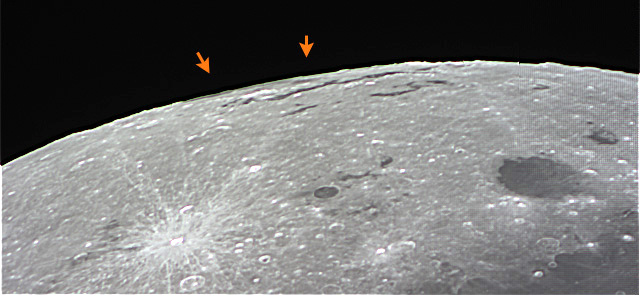
I finally have a picture that actually shows the middle of Mare Orientale
(the plain surrounded by mountain ranges). Here you are seeing it more or
less in cross section, right on the edge of the visible face of the moon.
Unfortunately, the mountain ranges don't show up as well here as they did
in my earlier shot. Also, this was taken with the
5-inch telescope, not the 8-inch.
If you're wondering why this is a big deal, look at
the space-probe pictures, which
show you Mare Orientale from directly above.
Also note that we are relying on lunar libration,
an effect due to the non-circularity of the moon's orbit, to help us
see beyond what would ordinarily be the edge. In the picture above,
we have 4.5 degrees of favorable libration. It is possible to get
slightly more, so I'm going to keep trying for a better view.
Plenty of the time, of course, you can't see Mare Orientale at all because it is
well beyond the visible edge at the time.
Permanent link to this entry
UFOs Klass-ified
Back around 1987, I had the pleasure of meeting the late Philip Klass, aviation writer and
UFO investigator. Recently I re-read one of his books, UFOs Explained.
This is a collection of "solved" UFO cases, where an unidentified flying object has successfully been
explained as something other than an alien spaceship.
I am a UFO skeptic in the tradition of Donald H. Menzel.
So is Klass, but if anything, he is more
aggressive and overconfident.
This book doesn't reveal just how badly he got along with other UFO investigators;
for that, you have to look at other sources.
Still, it must have been extremely trying to have to deal with "true believers" — people
who were convinced that any unidentified speck in the sky must be an alien craft — and there
are still plenty of "true believers" today.
I am not one of them.
I see no reason to even guess that an unidentified object in the sky is an alien spacecraft
unless you have some prior reason to believe there are aliens somewhere who can visit us
(who? where?), and unless you have eliminated possibilities such as rare atmospheric phenomena,
optical illusions, and, most of all, secret earth-based aircraft and spacecraft.
In any case, the "solved" cases are interesting.
I actually saw one of the objects Klass mentions — a huge experimental balloon that flew over
the Southeast in October 1973. To the naked eye, it was a bright spot in the blue daytime sky, too bright
to be Venus and moving too slowly to be an aircraft. I got out my 6-inch telescope, saw that it was a balloon,
and called the campus newspaper.
And in fact one of the useful data points in the book is that in the 1950s, there were many secret
high-altitude balloon flights which were declassified in the 1970s. Quite a few UFOs that couldn't
be explained at the time are now explainable.
The other point that comes out very plainly in the book is that people unaccustomed to looking at
the sky will "see" things very strangely. Venus, which always looks like a bright white star,
has been alleged to move around at high speeds, change colors, and sprout appendages. The appendages are
of course just defects in the viewer's eye; nobody has perfect eyes, and when you look at a very bright
star-like object, irregularities in the cornea and lens of your eye will show up as "smear" around the star.
Then there are objects that genuinely look strange, but have an unexpected, prosaic explanation.
An example is a glowing object that kept pace with an observer's car, even as he sped up or stopped.
It turned out to be a reflection of his headlights
from power lines beside the road. As Klass observes, if this person
had not investigated and found the cause, he would have only been able to report that at some point
the object darted away and disappeared (when the power lines no longer ran parallel to the road), and
it would have had to go into the "unsolved" file. Note: Extremely fast "darting" or non-ballistic
motion is a characteristic of reflections.
Particularly misleading are cases where people feel sure of the size and/or distance of an
unidentified object. That's just the observer's brain making a guess. If you don't know how big
something is, you have no way of knowing how far away it is (or vice versa), except that of course it is
farther away than things that it passes behind. Aircraft pilots, in particular, seem to be trained to
assume that any object is the size of an airplane, and to immediately guess its distance. I can tell you
from personal experience that people who have
never been around mountains, or flown in aircraft very much,
often think that everything is nearer and smaller than it is.
More generally, the function of the human eye-brain system is not to record visual images, but
to recognize and identify objects. Identification is part of seeing, and as you see something,
your brain will try to identify it and fill in the details. That is how we manage to recognize objects
so quickly in life-saving situations, but it can also mislead us.
A recurrent example is the way meteors are seen as "cigar-shaped craft" with bright windows.
A really big meteor tends to break up into several bright rocks that travel more or less in a row.
Around them there may be some faintly luminous gas, not nearly as bright as the particles themselves.
If you don't know what unusually bright meteors look like, but you do have a mental image of
an alien spacecraft, that's what you'll see — instead of an
extremely fast-moving cigar-shaped cloud with a row of
bright spots, you'll "see" an elongated craft with glowing windows.
This, in turn, ties into the way UFO sightings come in "flaps" — when a "flap" is going on,
and the newspapers are abuzz with stories,
everybody will see UFOs and will attribute spacecraft-like behavior to everything they
see that is even slightly unfamiliar.
I am struck by the fact that UFO reports almost never come from amateur or professional astronomers,
people who are experienced in looking at everything in the sky, including rare phenomena.
They more often come from pilots, who are trained in looking for aircraft but not much else, and who
are biased toward viewing unusual objects as aircraft.
Still more often, they come from "UFO enthusiasts," by which I mean space-alien enthusiasts.
Finally, what is the role of the UFO skeptic? If I believed we were getting extraterrestrial
visitations, I would still think that 99% or 99.9% of UFO sightings are something else, and I would thank the
skeptics for helping to explain them. Unfortunately, the "believers" do not seem to have appreciated
the way the "skeptics" have been doing them a service. If there is anything "to" UFOs, it will be in the
small number of cases that are sufficiently well documented but not explained. The explainers are
performing a valuable service by clearing away the rest.
Permanent link to this entry


|
2010
November
22
|
Some lazy astrophotography
All of these pictures were taken the lazy way — as a single
exposure (though some were later stacked) with dark-frame subtraction
done automatically in the camera ("long exposure noise reduction").
I was quickly checking whether the Crayford focuser would help me with
deep-sky work, not aiming for top-quality results.
Canon 40D on 8-inch telescope with f/6.3 compressor and autoguider.
First, the star cluster M35 and another smaller cluster next to it,
to check that I could focus well:
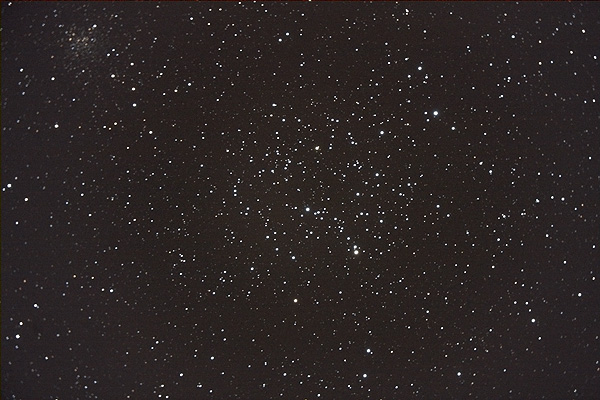
Next, the spiral galaxy M77. This is a stack of a 1-minute, a 5-minute,
and a 6-minute exposure, and you're looking at a small central area of the
picture, not the full frame:
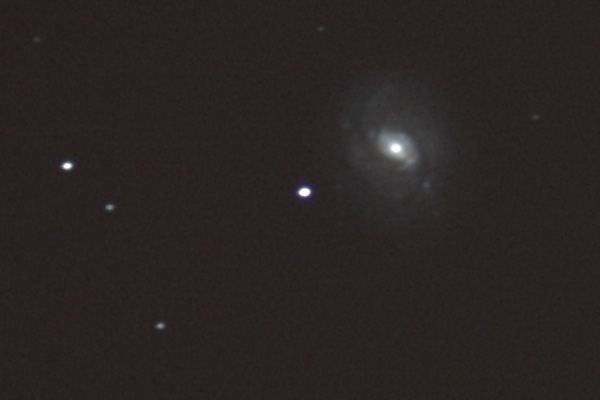
Finally, an attempt at HDR (high-dynamic-range) imaging of the Orion Nebula (M42).
The alignment is not perfect. This is a stack of an 8-second exposure, a 30-second
exposure, and a 2-minute exposure. The streak near the top of the nebulosity is
a geosynchronous satellite going by (or rather rotating with the earth and hence
moving relative to the stars). Consider this a prototype for better pictures to be
taken with the same technique.
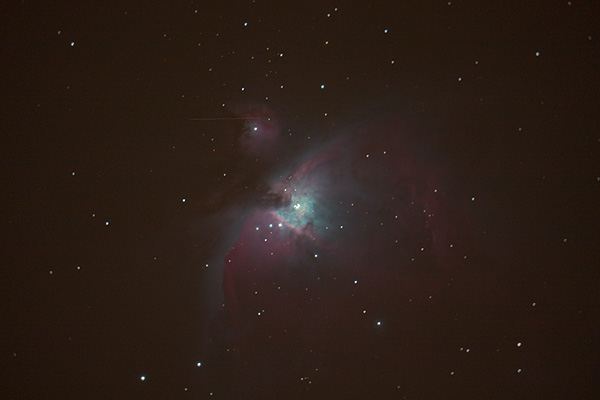
Some of you may have heard me express dissatisfaction with the align-and-stack feature
of MaxIm DL 5. I'm glad to report that in release 5.12, the latest update, it is
much improved.
Permanent link to this entry


|
2010
November
19-21
|
Jupiter and the Ramparts of Mare Orientale

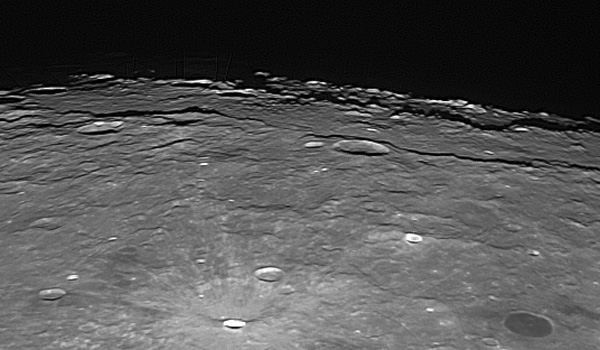
Here you see another rather sharp image of Jupiter, this time showing a white
spot in the North Equatorial Belt, and another view over the triple concentric
mountain ranges that encircle
Mare Orientale.
Each was taken with my 8-inch telescope and is a stack of more than 1500 video frames.
Both were done with the DFK (color) camera, but the latter one was converted to
black-and-white.
Permanent link to this entry


|
2010
November
18
|
Keith Burns, 1965-2010
Keith Burns, former president of the Atlanta Astronomy Club, was found dead in a wooded
area near a park this morning. He had been missing more than a week and an intensive
search had been going on. No further details have been released, and although I did not
know him well myself, I am among many who will miss him.
Permanent link to this entry


|
2010
November
17
|
DMK monochrome astrocamera mistakenly built with color sensor
Today's technical war story is odder than most.
For some time I've been using an
ImagingSource DFK-series
color video camera to photograph Jupiter.
(Readers will remember that my technique is to take thousands of frames
of video, then align and stack them using software.)
Well... I wanted to do monochrome infrared imaging of the current
outbreak in Jupiter's SEB, so I ordered a
DMK21AU04.AS
camera from the same series.
It arrived, and since we were having a rainy day, I didn't put it on the telescope.
Instead, I played with it indoors without a lens, making sure it could see variations of
light and shade in the room.
The images should have been featureless gray, but instead, they had a fine grid pattern in them,
like this:

I thought about that for a moment and said to myself, "That looks like the
Bayer matrix
in a color camera. It looks like I'm using a color camera in black-and-white mode."
I turned on Bayer decoding, and voilà — the camera could see in color!
Apparently this DMK camera was built with the image sensor of a DBK-series camera,
and the electrical requirements of the two sensors are so similar that it worked.
But it's not what I wanted...
so the dealer is sending another one, and we hope the whole batch does not have the
same problem.
Permanent link to this entry


|
2010
November
16
|
Notes from all over
Copyright scandal of the day:
As everybody knows by now,
Cooks Source Magazine stole material from web pages, then, when challenged,
brazenly told an author that the whole Web is "public domain," which it isn't.
(Look carefully; there's a copyright notice on this page. I'm no fool.)
More about this ongoing drama here.
It looks as if they're out of business, which is a pity, because they need to stick around and be sued by
their other victims.
A while back, I said that back when Social Security was being set up, 65 was the average age of death
of able-bodied workers. The Social Security Administration says
that in 1935, the life expectancy of 65-year-olds was 12.5 (more) years.
Was I wrong?
No. I checked. If you made it to 65, you were indeed good for quite a few more years; but your odds
of making it to 65 were only 50-50. There were far more deaths in young adulthood and middle age then than now.
Flash forward to today. I thought it was uncontroversial that the Social Security retirement age needed
to rise just a little, to adjust for the great increase in life expectancy. But I've just been arguing with
some liberals who approach this from a different direction. Instead of asking what is financially feasible, they are
asking whether "blue-collar people should have to work" past age 65, and arguing that extending the retirement
age to, say, 68 or 70 is undue hardship.
Well, I can dream of a world in which "blue-collar people"
don't "have to work" at all, but dreaming doesn't make it so.
(Let me clarify that I am not unaware of the physical challenges of blue-collar work. But if too many jobs can
only be done by young adults, that is not the problem Social Security was set up to solve;
we need to be thinking about working conditions and career paths.)
Incidentally, blue-collar workers' life expectancy hasn't risen as much as everyone else's,
but the reason is simple: Smoking.
A related point: Where do people go to quit smoking? College.
Apparently, one of the best things you can do for public health in a rural area
is to open a community college.
Why? Maybe a change in social class status and role models; maybe a change in a person's
attitude to facts. When they've been to college, they no longer feel that they have
a license to ignore things. Less educated people have heard that smoking is bad for them,
but they think it's a claim that comes from, and belongs to, a different world, not part of
the little world in which they live. Going to college breaks this boundary.
My college friend Paul McGlasson is now an up-and-coming Presbyterian theologian.
In one of his books,
he has lucidly pointed out two things that are wrong with
fundamentalism:
- It is defined by, and thus dependent on, what it rejects.
Without modern culture to thrust against, fundamentalism would be pointless.
(As the Rev. Jim Griffith said to me many years ago, "If you take the 'knock'
out of some of these people, there isn't anything left.")
- Fundamentalists fail to realize that their interpretation of the Bible is
an interpretation. (Doctrinally conservative non-fundamentalists, such as myself,
would argue that it is close to the right interpretation; but a real fundamentalist
denies that it is an interpretation at all.) Thus they fail to recognize an essential
fact about human communication, which is that
reasoning and decision-making are required
of the recipient
of every message. This may be connected to a vague notion that the Bible communicates
miraculously.
Click the link to read more.
Permanent link to this entry


|
2010
November
15
(Extra)
|
A minor technical improvement
You should be having considerably better luck getting the latest version of this blog
every time you go to it,
without having to hit Refresh. For the cognoscenti, the HTTP headers on Default.asp have
been modified to include a short expiration time.
Permanent link to this entry


|
2010
November
15
|
Windows File Sharing very slow, Internet access OK
I've just spent most of the weekend repairing our backup server, which was
showing the following symptoms:
- Windows file sharing was very slow (about 1 megabyte per minute to copy a file
from the server to another PC) and during the copying operations, the server was
quite unresponsive, not even responding to mouse movements on the screen.
- Internet access was unimpeded; the DSLreports speed test was the same as on
any of our other computers (much faster than Windows file copying).
-
There were no indications of anything wrong in the event logs, except that very
occasionally, the computer was unable to get to the network at all.
There are many software solutions to this problem on the Internet, and I tried them,
and they didn't work.
The key symptom — long delays without error messages in the log — indicates
hardware trouble. The operating system is asking the hardware to do something that can take
an unpredictable (but not unreasonable) amount of time, and is waiting as long as it takes
without complaining. The hardware is taking far longer than it ought to.
Similar symptoms in the past have clued me in to disk drive and USB controller failures.
Well, cut to the chase — it was a hardware failure. I disabled the onboard
Ethernet controller and added a new one ($25 from Best Buy). All fixed.
The only other confounding factor is that the blue slot in an ASUS P4PE motherboard
is apparently not quite PCI standard. My USB adapters work in it but the Ethernet
card did not. Weird.
Permanent link to this entry


|
2010
November
14
|
Nokia 7020 review and note about cables and adapters
[Updated.]
 My new Nokia 7020 cell phone is serving me well.
By way of background, this is one of the new ones that you can buy,
unlocked, from Nokia and from
vendors such as Amazon.
It's ready for any digital network such as AT&T or T-Mobile — just put in your SIM card.
My new Nokia 7020 cell phone is serving me well.
By way of background, this is one of the new ones that you can buy,
unlocked, from Nokia and from
vendors such as Amazon.
It's ready for any digital network such as AT&T or T-Mobile — just put in your SIM card.
The phone contains a 2-GB camera, an MP3 player, and an FM radio. The latter two are going to come in very
handy, especially when I'm traveling.
There's a slot for a micro SD memory card, and to my delight, a 2-GB card was already in it when I
opened up the phone.
The easiest way to transfer files to the phone is either to move the memory card to your computer, or
to hook up the phone using any micro USB cable (Nokia's CA-101 or any other brand).
A micro USB connector is slightly smaller than the mini USB connector used on cameras (see below).
Apparently, no device driver is needed if all you're doing is reading and writing the memory
card in the phone. Software for doing other things can be downloaded from Nokia (and, in my
experience, will pester you frequently offering to update itself).
A pair of Nokia ear buds is included.
If you want to use regular (Walkman-type) headphones with this telephone,
what you want is a common 3-conductor (stereo) 2.5-mm
to 3.5-mm adapter (I don't know if Nokia makes this, but others do)
not the Nokia AD-61 or any other adapter that has a 4-conductor plug.
The Nokia headset has a 4-conductor plug, but the 4th conductor (the ring nearest
the sleeve) is for the microphone. It is correct for this to be joined with
the sleeve (without the third black band separating them)
when your headset doesn't include a microphone.
I made my own adapter, simply wiring corresponding pins of the 3.5-mm stereo
socket to the 2.5-mm stereo plug, and it works.
I have since learned that this adapter is widely available.
It is a 3.5-to-2.5-mm stereo adapter, not "cell phone" adapter.
The plug has 3 metal areas (not 4) with 2 black bands (not 3) separating them.
These latter two facts were unknown to Nokia tech support and are not on Nokia's web site.
Permanent link to this entry
Types of USB connectors
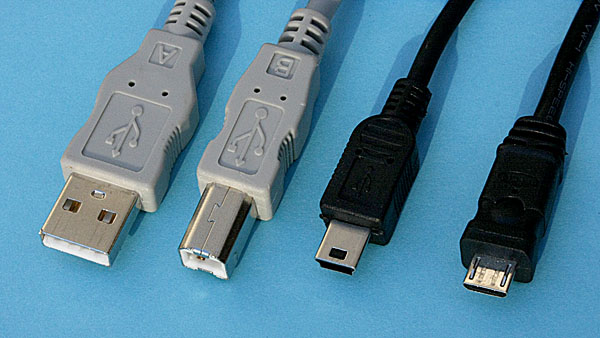
Left to right: A, B, Mini B, and Micro B USB plugs.
There is also an A socket, used on extension cables.
The Mini B and Micro B are almost exactly the same size.
(Mini B is thicker and more T-shaped.)
As I learned yesterday, Mini B is used on cameras and Micro B is used on cellphones.
Permanent link to this entry


|
2010
November
13
|
Jupiter with two red spots

Here you see Jupiter with the Great Red Spot and another prominent
red oval. At the suggestion of Christopher Go, I recorded only two
minutes of video this time (so the planet wouldn't rotate as far)
and used a higher frame rate. Traditionally I have been recording
four minutes of video each time.
Permanent link to this entry


|
2010
November
11-12
|
Jupiter spot
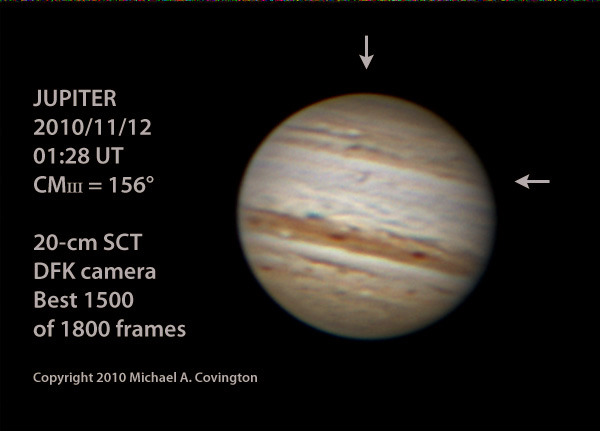
Here you see the spot that represents the start of the return of Jupiter's
missing South Equatorial Belt. The spot was discovered by amateur astronomer
Christopher Go a few days ago. It is very bright in infrared light. I have
ordered an infrared camera and hope to have some infrared images soon.
Permanent link to this entry


|
2010
November
9-10
|
Thin moon
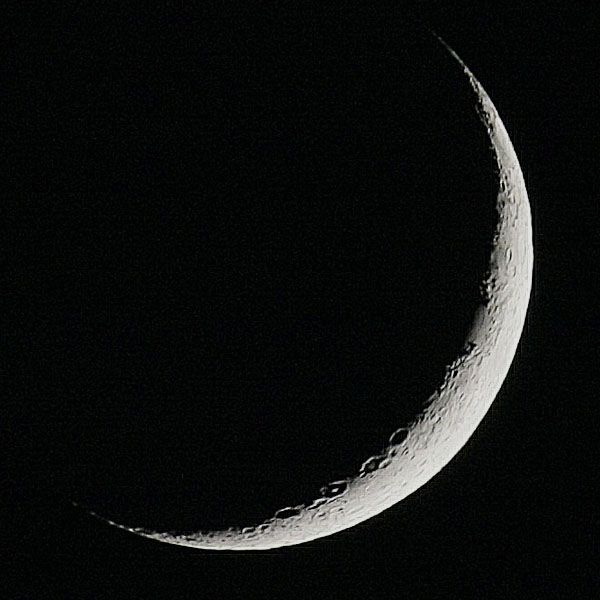
This was a quick and easy astrophoto — Canon 40D, 300-mm lens, and 1.4x converter
on a tripod, exposed in Live View mode to minimize vibration, sharpened with RegiStax.
More quick and easy astrophotography is coming tomorrow. I'm too busy to do anything hard!
Permanent link to this entry


|
2010
November
8
|
In further praise of a cheap watch
and other thoughts on timekeeping
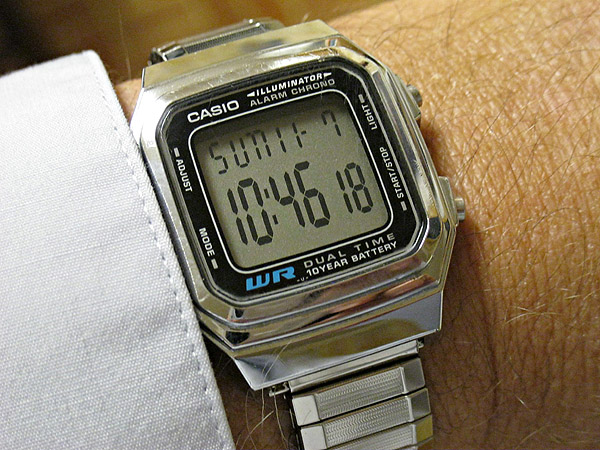
Melody and I shopped for a new watch for me on Saturday night, and
after looking at lots of alternatives, I decided to stick with my newly
repaired Casio A178W. If it fails again, I'll get another one just like it
(it's still made).
We saw some strange things in the stores.
Any watch that does anything useful is classified as a "sports watch,"
no matter how dressy it looks.
"Dress watches" have analog dials more than 2 inches in diameter,
presumably for stage presence, so your friends on the other side of
the room can see your bling.
Bulova is still making all-mechanical self-winding watches.
Why? That was a great technology for 1955, but it has been
obsolete for thirty years.
I like the A178W because of its good ink-to-information ratio
(almost everything on the screen is actually meant to be read)
and because of its compact, thin design. Notice how, in the picture,
it doesn't catch or chew up shirt cuffs. And it takes a standard band
— I think I have a $25 band on a $16 watch.
A new technology to watch: Not only wall clocks, but also some
Casio wristwatches pick up longwave radio signals from
the atomic clock at WWVB in Colorado
and set themselves automatically. When it works, that's very handy.
I'm told that these watches have some trouble setting themselves in Georgia,
though, and have to be left on the windowsill overnight (or outdoors, if
you're brave).
We need more than just one longwave transmitter in Colorado.
My idea is that there should be a digital time-signal "chirp" transmitted
along with the hourly station ID of every FM broadcast station.
Unlike WWVB, it would only be accurate to maybe 0.1 second (not 0.001 second),
but that's plenty good enough for almost every human activity, including
the broadcast industry itself, which already uses various kinds of time beeps
internally. And the signal would be strong enough to pick up anywhere.
Perhaps a dubious move: These same new watches use a solar-powered rechargeable
battery, and the instructions say not to wear them inside a sleeve or cuff,
or they won't get enough light. Oops.
Quartz accuracy: One of the blessings of modern life is that everybody
has an accurate watch or clock. It's no trouble to keep a group of people
synchronized to the minute.
"Back in the Day" (i.e., circa 1970), life was very different. A cheap mechanical
watch could easily drift 2 minutes in 24 hours. Different people's watches and
clocks commonly differed by 5 minutes or more. Polite people always showed up
for appointments 10 or 15 minutes in advance, because if your watch and theirs were
off by 5 minutes in opposite directions, there might not be any time to spare.
Nowadays I can schedule a meeting at 2:00, and at 1:59 people will start coming
into the room, and by 2:00:30, they'll all be sitting down. No need for ten
minutes of anticipation.
Strange powers? In high school, I had a rather fancy watch (originally my father's)
with a second hand that could be set. (Most watches could be set only to the minute.)
Naturally, like everybody else, every morning I set my watch to match the school's bells,
which were a few minutes off Eastern Standard Time.
I found that I could do this to an accuracy of better than a second (really; the second hand
moved in 1/4-second jumps). Then, at the end of
class, I would close my book and start to stand up about half a second before the bell rang.
Nobody could complain, because by the time they saw me the bell was ringing, but they
were haunted by the thought that they saw me move before they heard the bell.
How did I do it?
That experience, by the way, instilled in me a value that I still live by.
I start classes precisely on time, and I end them on time or slightly early.
I am not one of those selfish professors who gets into a lecture and says,
"I know class is supposed to be over, but bear with me a few more minutes..."
meanwhile keeping the students from their next class.
Paradoxically, the inconvenience of Daylight Saving Time comes from the fact that
clocks are so accurate, and so numerous. "Back in the Day," every clock needed setting
every few days anyhow, and a household wouldn't have more than three or four of them.
This year, here's how the clock-setting rounds went:
- The computers took care of themselves.
- Two "atomic" wall clocks took care of themselves.
- The cell phones took care of themselves when turned off and on again, but not before that.
- I had to set 2 wall clocks, 2 alarm clocks (his and hers), clocks in 2 cars,
and the time in 4 digital cameras and 1 digital voice recorder.
We are told that Daylight Saving Time "saves energy" and that it "helps the outdoor
recreation industry." To which I say, "Make up your mind."
Permanent link to this entry


|
2010
November
7
|
A ghost story
My office computer normally runs Windows, but on Friday I was setting up
Red Hat Enterprise Linux as an alternative, for a research project.
I have two monitors.
I was configuring the dual display and realized everything was exactly the way I wanted it
except that the left display was on the right screen and vice versa.
Since xorg.conf is a tricky and sensitive thing, I took the simple way out —
reached around behind the monitors and swapped the cables.
Presto — immediately the contents of the two screens were interchanged, and
that corrected the problem.
Then I booted into Windows, thinking I'll have to tell Windows to swap the screens,
since they had been set up correctly before I switched the cables.
In Windows, this is easy to do, so I wasn't worried.
Well... I started up Windows... and the screens were not swapped.
Each one was displaying the same thing as before I swapped the cables.
What gives?
I have no answers. My best guess is that, even though the monitors were both the same
model of Dell 19-inch, they somehow returned different identifying information to the OS,
and Windows was able to tell that I had swapped them.
Or maybe it's still close enough to Halloween...
Permanent link to this entry


|
2010
November
5-6
|
Are wristwatches at an evolutionary dead-end?
 The other night I went shopping for a new wristwatch, but I ended up not buying
anything, and then, fortunately, successfully repaired
the old one. (Casio A178W, shown in the picture; one of the few
present-day wristwatch designs that I like.)
The other night I went shopping for a new wristwatch, but I ended up not buying
anything, and then, fortunately, successfully repaired
the old one. (Casio A178W, shown in the picture; one of the few
present-day wristwatch designs that I like.)
The evolution of wristwatches puzzles me. There was a revolution in the 1980s:
we put aside our analog mechanical watches and got quartz watches
with nice, big, legible LCD displays. A wristwatch was easier to read, and less trouble
to maintain, than ever before. What's more, it had extra features such as a stopwatch and
an alarm.
But today, when I want a watch of that general type, the pickings are slim!
I have three choices:
- Sport watches, which have the functionality I like, but are big and black
and don't take standard watchbands. They don't look elegant enough to wear with
a suit and tie.
- Dress watches, which have analog dials and are often excessively close imitations of
tired designs from the 1960s. (I have nothing against analog dials, but must we
imitate 1960s display mechanisms, with moving metal calendar digits and the like?
What is the best way to build an analog display today?)
- What I call "show-off watches" — fancy watches that look
like a parody of the gear of a 1930s aviator, with multiple tiny dials that cannot
really serve any useful purpose.
Why didn't the 1980s digital watch evolve into a better version of itself, with a
brighter and more informative display and a more elegant body? I don't know.
Besides adding functionality,
the obvious move would have been to improve the "ink-to-information ratio" by
getting rid of needless writing. We don't need the full specifications of the watch
written on the front. They're there because, originally, the LCD wasn't big enough
to fill the whole face. Make it bigger, and you have a better watch.
But very few watches are made this way.
I have an idea what's going on. First, wristwatches are no longer ubiquitous.
Three quarters of my students don't wear them — instead, they use their
cell phones as timepieces. The obvious advantage is that the time is kept correct
automatically by the telephone network. The disadvantages are that you have to pull
it out of your pocket, and in many cases press a button, to find out what time it is.
If cell phones are not permitted (e.g., during an exam, or in a courtroom), you can't
tell time. I like being able to look down at my wrist and see what time it is.
Second, because of falling prices, the watch industry is confused about what
it's selling. They're trying to trade on the memory of how expensive a good
watch used to be and what it used to look like.
That is why we are getting parodies of 1930s chronometers instead of elegant watches that
make the best use of today's technology to do today's job.
Permanent link to this entry
Short notes
I am delighted to find that unlocked quad-band international cell phones, usable on any
GSM carrier anywhere in the world, are now readily available in stores and are not very expensive.
(No more working the black market to get someone to unlock one.)
I've just ordered one from Nokia.
Don't believe everything your computer says:
Reportedly, an error in Google Maps has caused
a minor
military conflict in Central America!
Permanent link to this entry


|
2010
November
2-4
|
Theories and data in theology
This is not going to turn into a theology blog, but the previous entry got 1000 hits
in 3 days, so maybe I'm onto something. (Or maybe a large crowd is gathering to
brand me a heretic.) Anyhow, I want to make one more point.
I'm a scientist. All day long I deal with theories versus data.
On the basis of data, we formulate theories, which encapsulate our understanding,
and then we test the theories against the data.
I think something similar goes on in theology, except that the process sometimes
goes awry.
Calvinism, for instance, is a theory. It is a system of theology that attempts to
present, in neat and logical form, the content of its data (Holy Scripture and various sources
of background information). Arminianism, classical Lutheranism (the theology, not the church),
and Thomism are others.
As long as the theory remains subordinate to the data — as long as the goal is to use
Calvinism to help you follow Christ, not the other way around — you're on solid ground.
The theory is constantly vulnerable to testing, and hence improvement. If it becomes too
hard to correct, you'll throw it out.
A bad thing happens, whether in theology or in science, when a theory begins to be treated
as superior to the data, so superior that people neglect or flatly deny the data.
Every theological system has a few advocates of this kind.
They are more interested in using Christianity as a foundation for X-ism (for some value of X)
than using X-ism to help them become better Christians.
Scientific theories have advocates of this kind, too, and one often watches them go down
with sinking ships.
Permanent link to this entry


|
2010
November
1
|
Confessions of a humble Protestant
Today, November 1, is All Saints' Day, the day Christians honor their great
predecessors in the faith. The day I am writing this, October 31, is the
anniversary of Martin Luther's 95 Theses.
And today I want to reflect on the current, divided state of Christendom and my place in it.
To put it bluntly, although I see that the divisions had to happen, I am not proud of them.
To me, being a post-Reformation Christian is like having divorced parents — no matter
where you go, it's not really home.
If you are looking for someone who will extol one particular church and say that all the
others are bad, look somewhere else.
I am too well informed about Eastern Orthodoxy, Roman Catholicism, and Protestantism to consider
any of them the enemy, or to consider any of them flawless. None of them claims to be flawless.
Apart from issues of ecclesiology — how the church should be run — the most fundamental
issue dividing Christians is how salvation is obtained — how people are reconciled to God.
We agree that our salvation was won by Christ on the cross.
But how do we receive it? Does Christ choose us or do we choose Christ?
I think the truth is a sacred mystery — not something deliberately withheld from us, but
something beyond the ability of our minds to comprehend. In my opinion, both extreme Calvinism
("He chooses us and we have no say in the matter") and extreme Arminianism ("We choose Him, and if
we don't stick with the choice, we lose Him again") are oversimplifications. They are like the wave and
particle theories of light. Each of them gets some things right at the expense of others.
Following the Bible, I affirm that we
are saved by grace through faith, not by our own accomplishments.
Salvation is an undeserved gift from God. That is the great Calvinist insight,
a powerful remedy against the universal human tendency to claim credit for ourselves
for what God has done.
But I also follow the Bible in affirming that
if faith does
not bear fruit in behavior (such as forgiving your enemies),
it is not saving faith.
The great Orthodox and Catholic insight is that
placing one's faith in Christ takes time and
involves behavioral commitment.
Protestants sometimes express part of the controversy as "once saved, always saved."
If you have put your faith in Christ, can you withdraw it and go back to being unsaved?
That is, suppose you make a faith-commitment at time T and withdraw it at time T+2.
If you die at time T+1 you would go to Heaven but if you die at time T+3 you would
go to Hell. Is that how it works?
My reply to this one is: I hope I've made the question sound as silly as it is.
All Christians agree that your salvation is not something you accomplish by
making some kind of act of faith. And all human beings agree that you only get
to die once. The Biblical view, I think, has to be that if you totally lose your
faith, we can't quite tell which of two things has happened. Maybe you never had
it in the first place. Or maybe you still have it, but it's hidden under a burden
of sin, and you'll still get into Heaven but will require considerable cleaning up
when you arrive.
I cannot accept the "one-transaction" view of salvation — "say this prayer and
instantly you are saved." I would say, rather, "say this prayer and you have begun
to lay claim to the salvation Christ has prepared for you." The prayer itself isn't what
accomplishes it. This is not to discourage people from repenting and turning to Christ!
Just understand that the first minute of Christian life is not the whole thing.
But I absolutely cannot accept the undue pessimism about one's own salvation that seems
to plague Roman Catholics. If you spend your life trying to follow Christ, of course
he's going to save you. Here I side with the Calvinists and say that if He had not
chosen you, you would not have wanted Him. You are not studying for a tough exam.
You are receiving a free gift. Your whole life of Christian growth, of works and
sacraments, is a process of claiming and benefiting from this gift.
And, in terms of ecclesiology, let me just say that I can't buy the oversimplified Protestant view
that real Christianity died out in the second century until the Reformers revived it 1300 years later.
(Few people actually claim this, but many often talk is if they did.)
That would imply that Jesus failed to found a visible Church.
On the other hand, I don't think Jesus intended his Church to operate like the Roman Empire,
with a single point of control which turned into an efficient means for leading the whole thing
into error at once. When Friar Tetzel started selling indulgences for money,
the Reformation had to happen, but it was a sad necessity rather
than a glorious triumph.
There. I have probably said enough to offend everyone. Fortunately, this blog doesn't
have a comment section!
Permanent link to this entry


|
|
|
This is a private web page,
not hosted or sponsored by the University of Georgia.
Copyright 2010 Michael A. Covington.
Caching by search engines is permitted.
To go to the latest entry every day, bookmark
http://www.covingtoninnovations.com/michael/blog/Default.asp
and if you get the previous month, tell your browser to refresh.
Entries are most often uploaded around 0000 UT on the date given, which is the previous
evening in the United States. When I'm busy, entries are generally shorter and are
uploaded as much as a whole day in advance.
Minor corrections are often uploaded the following day. If you see a minor error,
please look again a day later to see if it has been corrected.
In compliance with U.S. FTC guidelines,
I am glad to point out that unless explicitly
indicated, I do not receive payments, free merchandise, or other remuneration
for reviewing or mentioning products on this web site.
I have a Canon EOS 20Da camera and a Tektronix
TDS 210A oscilloscope on long-term loan from their manufacturers. Other reviewed
products are usually things I purchased for my own use, or occasionally items
lent to me briefly by manufacturers and described as such.
|
|











 My new Nokia 7020 cell phone is serving me well.
By way of background, this is one of the new ones that you can buy,
unlocked, from
My new Nokia 7020 cell phone is serving me well.
By way of background, this is one of the new ones that you can buy,
unlocked, from 




 The other night I went shopping for a new wristwatch, but I ended up not buying
anything, and then, fortunately, successfully repaired
the old one. (Casio A178W, shown in the picture; one of the few
present-day wristwatch designs that I like.)
The other night I went shopping for a new wristwatch, but I ended up not buying
anything, and then, fortunately, successfully repaired
the old one. (Casio A178W, shown in the picture; one of the few
present-day wristwatch designs that I like.)